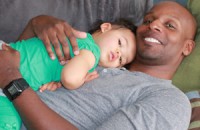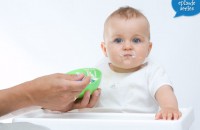Parent Savers
Ease Your Child’s Separation Anxiety
Dr. Scott Koenig: Separation anxiety is a stage of development in which the child experiences anxiety when they are separated from their primary caregiver: usually the mother. Although the child is expressing a normal and essential survival instinct, it can also leave to some significant tantrums and meltdowns, and many parents find it problematic if it continues as the child gets older. I’m Dr. Scott Koenig, a licensed clinical psychologist, and this is Parent Savers, Episode 47, helping parents deal with separation anxiety.
[Intro]
Johner Riehl: Welcome, everyone, to Parent Savers broadcasting from the Birth Education Center of San Diego. I’m Johner Riehl, and as your host I’m here to have conversations about subjects that parents of young kids care about. On Parent Savers, we engage with experts in the field as well as parent panelists just like you. We’ve got a couple in the studio, but we also want you to be a part of the show as well; so give us a tweet, call our hotline, leave a comment on our Facebook page, vote in a poll, send us an e-mail, do whatever it takes to helps us help you get your questions answered and comments heard on Parent Savers. And in addition to listening and participating, please make sure to visit our website, too: www.parentsavers.com, for more information about the topics we discuss-and while you’re there, make sure to sign up for our free newsletters so you can stay up to date. And we also have a Parent Savers Club where you can download the archived episodes and get exclusive content and more. So make sure to visit parentsavers.com for more info on that. A little bit about myself; I’m a new-again parent. My third son, Zyler, is a one and a half, and we also have two older boys, Quinner and Whitaker, who just turned six and for-and I’m joined by a couple of other new parents in the studio.
Ursula McDonald: Hi, I’m Ursula McDonald, I’m thirty-five. I’m a part-time office manager and a full-time mom of two boys: Desmond who is four and Callan who is two.
Amy Askin: And, I’m Amy Askin, and I am a mother of three girls-the three mermaids, as we call them: Olivia who is eight, Serene who is three, and newborn Elysiana.
Johner Riehl: And she’s actually with us in the studio today. [Laughter] Dr. Koenig, how about you?
Dr. Scott Koenig: I have two children. I have a six year old boy and a four year boy, and hundreds of others-but they get to see me only once a week-they get to go home to their moms. [Laughter]
[Music]
Johner Riehl: One of our listeners, Laura from Rhode Island, tweeted us this question: “My twenty-seven month old little boy has been potty-trained for a solid two months, but in the last three days he’s regressed and started pooping in his underwear-any ideas?”
Dr. Frederick Johnson: Hi, it’s Dr. Frederick Johnson calling in. It sounds as if you have a normal twenty-seven month old that hasn’t quite got the whole idea of potty training down, or he has an issue with something else going on in his life that he’s decided he wants to take control. So this is where patience comes in and you’ll just need to be re-introducing him to the potty chair and hopefully he will get the hint, but boys always seem to take longer, and especially with pooping. So, that would be my suggestion. So, hope that answers all your questions and I’ll talk to everyone later. Bye-bye.
[Music]
Johner Riehl: It makes sense that infants and toddlers are scared to leave the safety of those who care for them the most. But that doesn’t make it any easier to deal with it when you’d like to, for example, go to the bathroom or-the heavenly grail for parents-take a shower. But today we’re talki9ng about separation anxiety with Dr. Scott Koenig, a clinical family therapist based here in San Diego, and someone I’m very excited to have on the show. Welcome, Dr. Koenig.
Dr. Scott Koenig: Thank you so much. Thanks for having me.
Johner Riehl: So let’s start, I guess, by talking about what separation anxiety is. Can you just tell us a little bit about what it is and what we mean by that?
Dr. Scott Koenig: Sure. Well, when we’re looking at separation anxiety, we’re looking at intense anxiety that a child experiences when they are separated-or the threat of separation from-their primary caregiver, typically from their mother. Though separation anxiety is a perfectly normal part of childhood development, it can be unsettling at times.
Ursula McDonald: What is it that causes that separation anxiety? Because you know when they do have that, maybe if you understand a little bit of what’s causing it, maybe you can help mitigate it a little bit?
Dr. Scott Koenig: Sure, Yeah. Well, somewhere between-I’d kind of like to say-six to eight months, babies develop what we refer to as object permanence, and they begin to understand that things and people exit when they’re not present. Babies realize that they can no longer see mom and dad, and that means you’ve gone away-that causes anxiety and because babies don’t really have the ability to really have the concept of time, they don’t understand yet that when a mother or father leaves the room that they’re not going to be coming back. So that, kind of, is those initial signs of anxiety. A parent can be at work or they can be in the next room, and the way the child experiences it is exactly the same.
Johner Riehl: So, do all babies on some level experience it? And it’s just a matter of how they deal with it that’s different?
Dr. Scott Koenig: Yes, to a degree, as it’s a part of normal, healthy development and attachment. But if you look at separation anxiety on a spectrum, some babies will experience it more and some will experience it less.
When we look at how this fits into the nurture vs. nature question that one needs to ask themselves; a child’s on disposition can certainly play a role, but how a parent responds to their baby’s needs can also exacerbate anxiety or help to reduce it.
Johner Riehl: So I guess kind of said it different ways; it’s there naturally, but it also can be molded and changed by how we, as parents, deal with it?
Dr. Scott Koenig: For sure, yes. So your children respond to temperament. So a parent who’s more calm and cool and collected-see the way I’m talking right now? [Laughter]
Amy Askin: We’re all falling asleep. [Laughter]
Dr. Scott Koenig: Oh, everyone’s falling asleep; well that’s a good thing, right? [Laughs] So, you know a parent’s temperament plays a role as well. All kids are going to experience anxiety, so that’s something that is very common and very typical and very normal. But, you know when a child is emotional and a parent responds to that in an emotional way, often we’re going to see a heightened level of anxiety. But typically, when a parent can remain calm in those situations and really be consistent with the tone of their voice and their strategies, often you’ll see a reduction in anxiety.
Johner Riehl: That’s interesting. Amy and Ursula, do you guys have some experiences with separation anxiety with any of your multiple kids?
Amy Askin: Definitely. My eldest child is, um, high maintenance? [Laughter] She’s delightful but I think-especially because she’s the first-having been around tons of kids and having been an elementary school teacher, I had seen exactly what Dr. Koenig is talking about. As a kindergarten teacher, especially-although I think that the separation anxiety happens more on the parental end on that first day of school. [Laughter] But seriously, our eldest still-I mean she’s eight and a half-and she still at times, with my husband travelling and what have you-has a certain level of anxiety. And so we just talk through it, and like Dr. Koenig said, we make sure we define where he’s going, and when he’ll back. We have a strategy; we have kind of a set role-playing thing that we do and that helps a ton, and we definitely set up kind of fun activities to do, you know not I don’t want to say to not deal with it, but we definitely put that in place so she’s ready and she has something to look forward to and that kind of gets her mind off of it. But my second child does pretty darn well with it. I don’t know, she just seems a bit mellower and so she seems to handle it a little bit better. And I think, second time around, too, it’s a little easier for us as parents. You know, you get used to those triggers and you see what’s going on and you are mellower yourself. So….
Ursula McDonald: It’s seems, too, like when the kids are a little older and you can explain to them, you know “Mommy will come back.” And then when they see her, “You did come back!” But it’s hardest, I think, when they’re babies and like you said, taking a shower-you know I remember my oldest, and I was a new mom-and I had to take a shower because we had to go to the doctor’s appointment and I didn’t want to show the pediatrician that I hadn’t showered in who knows how long. So I’d set him up in the little bouncy chair, in the bathroom with a clear shower curtain-you know I’d only use the clear one-and have like some music going, and then he’d still scream and cry through the whole thing like it was the worst thing in the world. Then….
Amy Askin: I think every mom goes through that.
Ursula McDonald: Yeah. Or the car, too-my second one hated being in the car seat and facing backwards. And so, you know-yeah you want to remain calm and try and talk through it with them, but as their like this [!] as the parent you want to be like this [!]. So it’s hard to remember that you need to provide that kind of soothing energy when you’re responding to them.
Amy Askin: You’re activated, yeah. I’m finding that with this one, and it’s been three and a half years and so when she’s activated and really yelling, I’m like “Please be calm!!” And I’m trying to be calm but it makes me sad, you know? It’s very-you know.
Johner Riehl: Do you see that, Dr. Koenig? Either some of those examples they talked about or some of those situations that cause separation anxiety? Like maybe being in a large, crowded public place that’s loud-or maybe at nighttime-it kind of builds a little bit more?
Dr. Scott Koenig: Yeah, well it’s quite common for the anxiety to intensify depending on the situation and where you are, and you know some babies and toddlers will show more anxiety in public places, as you said-new places that they’ve never been to before-and certainly at nighttime that can be a very scary time for children. My wife and I refer to that as “the witching hour.”
Amy Askin: That’s what we call it in our house, too. Between 4:00 and 8:00. [Laughs]
Johner Riehl: The witching….evening?
Dr. Scott Koenig: Right, “the Witching Four Hours,” where the witch comes. But another thing to remember is that as your child develops, they will begin to pick up and read more social cues, and they will be able to see from your actions and behaviors that you’re about to leave, and the anxiety actually begins to build and develop before you actually leave the room or go to work or what have you.
Ursula McDonald: Well, that-I have a question about that now. Because my youngest is two, and on the nights when I do get a babysitter or something, it’s-at what point should I be introducing the fact that I’m going to be going, you know? Do I-I don’t want to do it too early and then have him anxious the whole day, but I don’t want to spring it on him last minute. Is there a sweet spot for somebody about that age of when to kind of let them know that they can be anticipating a separation?
Dr. Scott Koenig: Sure. I think most of the time what I recommend is that if a caregiver is coming during the day or at night-like a babysitter-that you schedule them to come a bit earlier, not five minutes before you’re running out the door. Have them come earlier, spend some time with you, let them see that you’re developing rapport with them as well.
Amy Askin: We tell them before dinner time-let’s say we’re going on a seven o’clock date or something-we tell them before dinner time. Then what we’ve gotten to do as we’ve had number two was we already setup-like every time we go out you pick their favorite things. Whether it’s their favorite dinner and favorite movie or something-something like bonding time that you as a family do-and you make it the caregiver’s. And I always have the caregiver-and that’s a good point-I’ve always had them come during the day, I think because I was a daycare person, I know because I’ve been on the receiving end of getting the anxious child. But if you get them during the day, and you have a little playdate of something, then you say, “Oh remember? Miss Ursula’s coming to watch you. You guys are going to have pizza from such and such, and you’re going to watch this movie together, you’re going to read this story…” and they’re like, “Hmmmm….” But then, they kind of buy into it a little bit better. Is that reasonable or is that-kooky? [Laughs]
Dr. Scott Koenig: No, I think rituals are great. You know, consistent rituals, consistent bedtime routines- but you’re right, it’s finding that “sweet spot.” You don’t want to spring it on them five minutes before you’re leaving the house, but you also don’t want to tell them too early where that anxiety is really going to be at its peak. So again, it’s finding that “sweet spot.” I like your idea of having a ritual, maybe it’s a favorite movie, it’s a favorite book; but you’ve definitely got to let them know that you’re leaving, and especially if your child is not sleeping through the night. You know, the worst thing that you want is for them to wake up and have a stranger come into their room and try to soothe them. So, you’ve got to kind of experiment. Every child is different, but you know-and hour before you’re going out, a couple of hours before you’re going out might be appropriate. But again, have that person who’s coming into your home if it’s a babysitter or a caretaker, have them come early. Have them come a bit on the early side so that they can see how you interact with that person. That should calm down some of that anxiety as well.
Johner Riehl: We’ve got to take a break, but I think we’ve started talking a little about some strategies to deal with separation anxiety, and we’ll talk about that even a little bit more on the other side here. So we’ll be right back!
[Music]
Johner Riehl: Hi! Welcome back to Parent Savers. We’re talking to Dr. Scott Koenig about separation anxiety. And in the first segment, we talked about what separation anxiety is, as well as starting to cover on some of the strategies to deal with some specific kinds of it. But now, let’s dig a little bit deeper into that as well look at some other angles for separation anxiety. Are there times, Dr. Koenig, that separation anxiety is OK? I mean, after all, these kids are looking to the person that’s their safety and their safety blanket. So what are some of the times when it’s OK and when do you kind of know when it crosses the threshold from being OK to being a problem?
Dr. Scott Koenig: That’s a great question. Well, it’s OK from the perspective that when it’s occurring at early stages of development, it’s a really strong indication that your child is forming healthy attachments to the primary caregivers. That is what we want to see. However, if intense separation anxiety lasts into preschool, elementary school, or beyond-and really is interfering with the child’s daily activities-those are some red flags. And it could be the sign of a more serious condition known as Separation Anxiety Disorder. So those are the kind of things we want to monitor.
Amy Askin: And then maybe, what are some other things parents can do to help babies with separation anxiety?
Dr. Scott Koenig: Ok, well as we were talking about before, in general I think the more mellow and flexible the parents can be, the more flexible the child will be. And the more nervous and tense and unwilling to part with the baby the parents are, the more likely the child will experience separation anxiety. As parents, we want to always keep in mind that one of the most important gifts-early gifts- you can give your child is really that ability to self-soothe. Meaning that you’re allowing them the opportunities to regulate their own emotions-so you want to keep it light. I tell that to parents a lot, “Keep it light.” Your baby is very tuned into how you feel, so you want to keep it light, and just create a lot of warmth and enthusiasm, especially if a caregiver is coming over. You want to be really excited about it, and try not to act upset-and try not to act sad that you’re leaving your child. Another strategy is: once you leave, you leave. Don’t come back!
Amy Askin: Huge one! That hearkens back to the kindergarten-first day of kindergarten.
Dr. Scott Koenig: Yeah, I was going to say, you see that a lot around school, you know? And the teachers are like, “Leave! Leave! I’ve got this!” And it’s hard, it’s hard. I’m not discounting the fact that it’s hard for a parent to see those tears.
Johner Riehl: That happens when we have to drop our kid off at the babysitter/daycare during the day. It’s so weird and counterintuitive; but the whole idea is get in and get out. It’s like “Alright, here he is. See you later! Have a good day. I’ll talk to you when we pick him up!” Because I don’t want to wait and linger any more right now.
Dr. Scott Koenig: Yeah. Yeah.
Amy Askin: My husband and I used to argue over who got to pick up, because she would run to your arms, and it was like you were the coolest person on the planet!
Ursula McDonald: Awww….
Johner Riehl: And then, you can also visit then if there’s updates you need, but drop-off it’s all business. You know, In, Out, Let’s Go.
Dr. Scott Koenig: You can also practice separation, in which you leave your child with a caregiver for brief periods and short distances at first, and if possible you try to have a consistent caregiver. Not somebody new each week or each month: someone consistent. A transitional object is also a really good recommendation; a little blanket, a stuffed animal, a little action figure-and I like to encourage parents to develop what I call a “good-bye ritual.” So it’s short and it’s concise and it’s not drawn out-and it can be something non-verbal like a hug or a kiss or it could be a very short phrase that you say every time when you’re leaving your child, so that it will kind of become a condition that you’re about to leave them.
Johner Riehl: What would be an example of a phrase?
Dr. Scott Koenig: Um, “Mommy loves you! Bye-Bye!” “Mommy will be back soon.” Or Dad-we’re not talking about dads at all.
Ursula McDonald: We’ve got two dads here.
Dr. Scott Koenig: I know, right? So just something really sweet, you know “Love you bye-bye,” “Be back soon.” Just short-you don’t want to have a long monologue, you know? [Laughter] You don’t want to draw it out too much.
Johner Riehl: You mentioned earlier and we talked a little bit about it; for it being normal around six to eight months, as they’re learning object permanence. I was reading a little bit about separation anxiety and that it’s “supposed to end” around the age of two years old. That that’s when they can kind of start understanding, I think, a little bit more-and the beginning-probably not time concepts-but the beginnings of that you’re coming back, and that it’s not permanent. But what happens if it goes past that? Even if it’s just a couple months, but going into a couple years? What happens?
Dr. Scott Koenig: Sure, good question. Well, I generally recommend to parents that if the behavior is still occurring past two years of age that the first step would be to start and collect some data and actually measure the behavior. That might sound very clinical, but it’s actually very easy. The three units of measurement I suggest are frequency, duration, and intensity. So, we’re looking to see how often the separation anxiety is occurring, how long it’s occurring for, and how intense is the anxiety. I would recommend measuring this for about a week or two. And after data collection, we can start to see if the separation anxiety…let’s say it’s not within what we consider normal limits any longer, and we can then develop and strategize more consistent behavioral interventions to help reduce your child’s anxiety. Then it kind of speaks to the question-raises the question of-How do you know what’s within normal limits? And you know it’s a bit of a gray area-I guess its mother’s intuition of father’s intuition: parental intuition. I think you know. I think as a parent if we’re really tapping into what’s going on with our child, we know if it’s kind of reached a point where, “Wow, this is no longer just normal kind of crying stuff when I leave. This is really kind of becoming a problem, and it’s not only interfering with my child’s well-being, but really the whole family system.”
Johner Riehl: So when you’re monitoring it. Is it a notebook? If you’ve had parents do this for you, is it a notebook or-you know, they have apps for everything else when you’re monitoring kids. [Laughs]
Dr. Scott Koenig: I know! They need an app for this! [Laughter] No, it’s like on a sticky or in a notebook, yeah. Because sometimes I think as parents-sometimes-we a have a tendency to kind of overrate or underrate things that are going on, especially new parents. So, I like seeing data, I think it’s really helpful-and one of the reasons why I like to collect the data is so we get a baseline. And then, if there are some behavioral strategies that we are going to try and implement, instead of just playing the guessing game of “Well, I think it might be a little bit better,” we actually have really proof that what we’re doing is actually working.
Amy Askin: Would that be something that you would try-I mean, I know it’s early on, this is a six week old baby-but we’re struggling with the sleeping thing and even during the day she’s kind of cranky and colicky and that kind of thing. Is that something worth doing? I mean, I know it’s very early, but we keep talking about when separation anxiety ends, but when does it even begin? Is this too early? Is this all just nurturing kind of stuff that we need to worry about, or-?
Dr. Scott Koenig: Yeah, and that’s a really good question. And I would say, usually around six months of age it really kind of starts to kick in and then anywhere from ten to eighteen months it’s probably at its peak, and then it can kind of persist and go on longer. But at this age, I don’t think it’s something that you need to be strategizing about, per say. [Laughter]
Johner Riehl: And the baby’s been in the studio this whole time, too.
Amy Askin: I know, she makes me a liar, see? You’re like,”Yeah, that baby doesn’t cry, what are you talking about?”
Ursula McDonald: What do you do when you see you’ve already moved past that babyhood stage of separation anxiety, and maybe it comes back when they’re a little bit older? How do you deal with that or should that be a red flag to you; that maybe the situation you’re leaving them in isn’t good?
Dr. Scott Koenig: Yeah, well, you know I think we’re then sometimes looking at if this persists-again, into preschool, elementary school, and beyond. You know, we may be looking at something which we refer to as Separation Anxiety Disorder. When it’s no longer within normal limits; and again, we have professionals in the field that can kind of help evaluate this and look at this. I would say for older children, some of the things that you may see which may be some of the red flags would be, you know-that something terrible will happen to someone that they love, worry that an unpredicted event will lead to permanent separation. For example, they may worry about being kidnapped or getting lost. They may have nightmares about separation, they may refuse to go to school, they may display a high level of reluctance to go to school-often kids will complain of physical symptoms; they’ve got a headache or a stomachache. Just you know, that clinginess that at a sort of point you know that shouldn’t be going on anymore.
Johner Riehl: So, as a parent who’s trying to deal with these issues, whether in the younger kids or the older kids, where can we turn to for help? What can we do if nothing we’re doing is working?
Dr. Scott Koenig: Sure. Well, you first-and I’d really, really like to drive this point home, you always first want to consult with your pediatrician or your family doctor. You always want to rule out anything medical before you do anything. So that would be the first thing that I recommend. If the separation anxiety is just going away naturally, you may want to schedule a consultation with a psychologist or therapist who works with children for an evaluation. Therapists who do specialize in working with children can often help a child by increasing their coping skills; helping them learn to self-soothe, which we talked about before; challenging their negative thoughts into positive thinking, we call that cognitive restructuring; giving them ne behavioral strategies to try; and help you as parents as well, empowering you and giving you different ways to look at situations and helping your kid through that as well.
Johner Riehl: Alright, I think we covered a lot of information on this show. I think that Dr. Koenig’s voice is an excellent reminder to one of the key tips to be calm and soothing and to help your kids.
[Laughter] So, thanks again Dr. Koenig, for helping us to learn more about separation anxiety. I really enjoyed having you on the show. Hopefully, you can be a part of Parent Savers again in the future. If you as a listener want more information about today’s show, go to the “Episodes” page on parentsavers.com, and we’re also going to link more information about Dr. Koenig and his practice there, and some other resources about separation anxiety. Actually, our conversation’s going to continue for just a little bit with Dr. Koenig after the show for our Parent Savers Club members, so stick around for that. And if you were interested in being a part of that, definitely sign up on our website. We’re going to talk a little more about ways to prepare babies for when we’ll be apart. We’ve covered that a little bit more, but we’ve got a couple more tips that we’re going to share.
[Music]
Johner Riehl: Before we wrap things up, here’s blogger Doyin Richards sharing some fatherly advice from his blog Daddy Doin’ Work.
Doyin Richards: Hi Parent Savers! It’s Doyin Richards from the blog Daddy Doin’ Work, which is all about being a new dad, and today I’m talking about what it was like on our first plane trip. I live in Los Angeles, and we flew to Hawaii for a family vacation. And listen: I will tell you right now, I lost sleep. I mean I don’t sleep as a parent anyway with toddlers, but I lost sleep due to worry. I was afraid my kid would just go nuts. But, it actually worked out pretty well because let me tell you, if you’re a new parent and your taking a kid on a plane, let me tell you how I dealt with it and it worked out really, really well. The first thing I did was I brought my iPad. Now, if you do not own an iPad, you go get yourself and iPad. I’m serious; it’s the best $700 you will spend in your lifetime. Nothing keeps a toddler more entertained than Dora the Explorer episodes, or movies, or maybe some of those apps that you can get on iTunes; like those “Duck. Duck. Moose” apps where they’re learning things-Awesome! Saved the day, it’s fantastic. So I highly recommend that. So the iPad-I also just made sure that she had some snacks available. I bought some new toys for her that I would bring out every now and then to keep her entertained-to surprise her. And before you knew it, the flight was over-and she slept through a lot of it, not by the use of any Benadryl, by the way. So that my tips for you guys: iPad, toys, games, it’s all good. I just want to thank you guys so much for listening, and if you have a parenting topic or an idea that you want to talk to me about, feel free to e-mail me through my blog at daddydoinwork.com, or you can go to my Facebook page which is Facebook.com/daddydoinwork-and we will see you next time! Thank you so much! Have a good one, bye-bye.
[Music]
Johner Riehl: That wraps up today’s episode. Thanks again for joining us. We’d love to hear from our listeners, so if you have any questions at all, give a tweet, leave us a comment on Facebook, we’ve got a Parent Savers Hotline, number is (619) 866-4775-send us an e-mail through the website at parentsavers.com. You can send me an e-mail there. Get in touch with us; we want to answer your questions. And don’t forget, we’re going to talk for a little bit more with Dr. Koenig right now for Parent Savers Club members. Next week though, we’re going to take a look at teething. Which I know is an issue that goes on and on and on, and a lot of times we forget that it’s happening. But we’re going to learn a little bit more about what it is and how to deal with it. So thanks a lot, everyone for listening to this episode of Parent Savers: empowering new parents.
[Exit Music/New Mommy Media Disclaimer]











